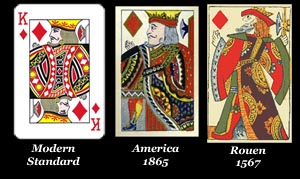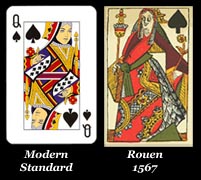
|
| « History of Playing Cards | Early Standards | Gallery of Playing Cards | Card Games | Card Backs |
The English Pattern
The English pattern comprises twelve court cards. The characters of the Royal household are dressed in elaborate English court costumes of the early 16th century. What is unique about the English pattern is that the Jacks are represented as foot-soldiers or landsknechts. This was characterstic of the French Rouen pattern from which it was derived. Both the Kings and Jacks are armed with mediaeval weaponry, like swords, shields and arrows. All the courtiers of the Royal Household are endowed with particular objects or ornaments that have served to define them. The assignment of these objects and ornaments has remained relatively unaltered over time.
The ancestor of the English pattern comes from a 15th century regional pattern of France known as the Rouen design. In the abundant variety of face designs that came in the centuries that followed, the French eventually abandoned the pattern altogether in the 1780s. Nevertheless, the Rouen pattern remained a highly influential design in the card markets of Europe for well on 400 years. The cards from Rouen were exported to markets right across Europe, to Spain, Italy, Switzerland, Flanders, Denmark as well as England. Similarly, a number of regions outside of France took up and manufactured the pattern including Flanders and England.
In England, it seems that the Rouen pattern was duplicated faithfully by English artisans from the early 17th century, and apparently without any alternative. However, the French design never found its finest incarnation at the hands of English ‘card masters’. They seemed to lack the finesse of their European counterparts. The fact that very few tangible examples of early English playing cards exist today is most likely because English cards crumbled to dust faster than anyone else’s.
Inevitably, the lack of skill and traditional craftsmanship meant that errors and distortions slowly crept into the design, with often what are described as “grotesque results”, and thereby mindlessly duplicated over time.
Because of this, by the time cards came pouring out of London factories by the 100’s of thousands in the 1830s, some notable though minor changes had occurred. It has left the English Court card a distinct standard in its own right.

Originally, the Rouen King of Hearts wielded an axe in his left hand. In the English pattern, the image had become so blurred and indefinite that eventually it was taken to be the hilt of a sword. In the English standard the King of Diamonds is nicknamed, “The Suicide King”, as the blade he weilds cuts back behind his head.
The King of Hearts faces slightly left as he did in the old days. He wears a gold crown, is attired in a red vest with gold sleeves. His right hand rests on his lapel. He is the only court card in the deck that still retains both hands.
The King of Spades looks to the right and holds a sword in his left hand. Originally, his right hand rested on his lapel. He wears red vest beneath red robes with blue trims. He has a gold crown.
The King of Clubs faces left. He holds an orb in his right hand and a sword in his left. The fingers of the King’s right hand disappeared some time over the 18th century. The orb has changed as well. In the Rouen Pattern, the orb was adorned with the Cross of Lorraine, but in the English pattern it became a simple cross, and then some time later, the fleur-de-lis motif, which it has now.

The King of Diamonds is seen in profile facing left. He is the only “One-eyed King” in the deck. He is dressed in red sleeves with blue lapels and he wears a gold crown. He is armed with an axe but lost the hand holding it some time in the 19th century. His remaining hand doesn’t seem to be doing anything except waving.
In the original Rouen design, the King of Diamonds is seen from behind. He is holding a poleaxe to his right, and looking to the left he has his other hand out as if about to break into song.
The Queen of Hearts wears a golden crown and a red cloak with gold hems, a gold check collar, and a gold herring-bone chest amulet. She faces to the left and carries a flower in her left hand.
The Queen of Diamonds wears a gold crown with black lining, a red gown with blue sleeves and a gold check collar. She carries a flower in her right hand and she looks to the left.

The Queen of Spades has a sceptre. She wears a gold crown with black trim and is dressed in a red gown. She looks to the right, and carries a flower in her right hand.
The Queen of Clubs wears a gold crown and is dressed in a red gown, with gold trims and blue sleeves. She looks to the left and carries a flower in her right hand.
The Jack of Hearts is one of two “One-Eyed Jacks” in the deck, the other being the Spade. He faces left and wears a plain red hat. He is armed with a halberd. Originally his right hand rested on the hilt of a sword, but this disappeared from the English pattern long before double ends were introduced. Nowadays the Jack of Hearts holds a small leaf in the fingers of his right hand.
The Jack of Diamonds still shows his hand holding the halberd, but his left hand, which originally rested on his waist, touching the scabbard of a dagger was a detail lost to double-ends. The Jack of Diamonds faces left. He wears a blue vest with a gold cravat. He has a plain red hat.
The Jack of Spades is seen in profile and faces right. The strange motif above his left hand is without explanation but it does offer us a clue. We are actually looking at him from behind as he glances over his shoulder. In the original, he stands like this holding a halberd or pike.

The Jack of Clubs faces to the right. He wears a red hat inset with three squares and decorated with a small leaf, presumably derived from a feather on an earlier French pack. It is difficult to make out what he is holding in his left hand. Some have suggested it might be a spear, pike, or a shield. In the original Rouen pattern, the Jack of Clubs is holding a long arrow with a turned shaft.
Further Reading
Regional Patterns of 18th Century France
The Rouen Pattern
Gallery of Early Standard Playing Cards
L I N K S
Pierre Marechal c. 1567 - The World of Playing Cards
History of Playing Cards - International Playing Card Society
| ||||||||
| ||||||||
| ||||||||
|
||||||||
|